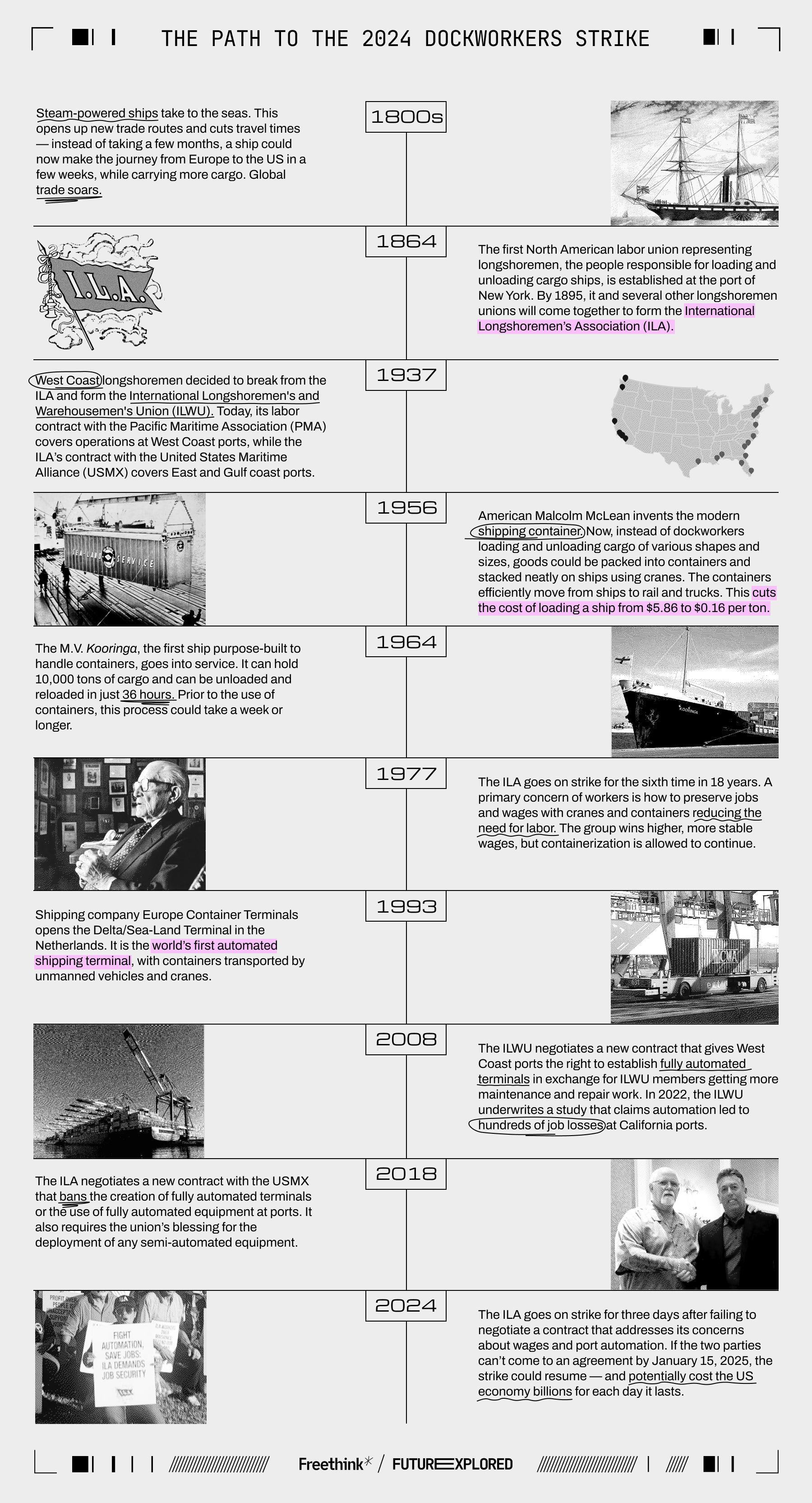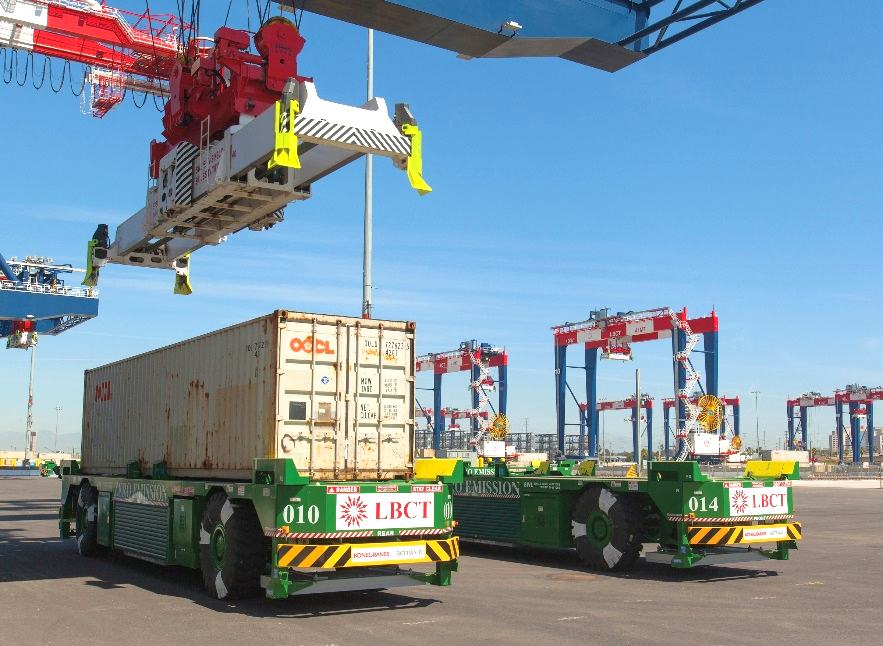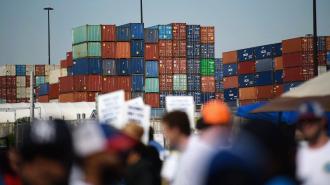This article is an installment of Future Explored, a weekly guide to world-changing technology. You can get stories like this one straight to your inbox every Saturday morning by subscribing above.
It’s 2035. You just started a job working at a US container port, but unlike the longshoremen of the past, you aren’t worried about losing a limb — or worse — while unloading a cargo ship. That’s because this port is semi-automated, and instead of sitting in the cab of a crane, you’re in an air-conditioned office, monitoring operations from behind a computer screen.
Port automation
For three days in early October, nearly 50,000 American longshoremen went on strike, grinding activity at the nation’s East and Gulf coast shipping ports to a halt.
This was the first strike of the union representing the workers — the International Longshoremen’s Association (ILA) — since 1977, and just like their predecessors, these workers were hitting the picket line to take a stand against technology they believed was going to put them out of work.
On October 3, the ILA and the group representing the port operators and shipping lines — the United States Maritime Alliance (USMX) — reached a temporary agreement that suspends the strike until January 15, 2025. If the pair can’t hash out a new contract by then, the strike is likely to resume.
To find out what’s at stake for workers, ports, and the average American, let’s look back at the timeline of events leading to the strike, what each side wants, and what could happen if they do — or don’t — get it.
Where we’ve been

Where we’re going (maybe)
The October strike ended swiftly when the ILA and USMX came to a tentative agreement about wages.
Just prior to the strike, the USMX was offering a 50% increase for ILA members over the course of the next six years, while the ILA was pushing for 77%. During the work stoppage, the two were able to agree on 61.5%, which will see a top longshoreman’s wage increase from $39/hour to $63/hour by 2030.
Now, they have roughly three months to work out the more difficult part of the contract: port automation.
The demands
The USMX wants the new contract to include the same language on automation as the current contract, which was signed in 2018: “There shall be no implementation of semi-automated equipment or technology/automation until both parties agree to workforce protections and staffing levels.”
The ILA, meanwhile, wants “absolute airtight language that there will be no automation or semi-automation,” ILA President Harold J. Daggett said on Day 1 of the strike.
According to the ILA, this change is necessary because USMX members have been sneaking automation into ports despite the current language. Contract negotiations broke down in June 2024 when the ILA discovered that the Port of Mobile in Alabama was using an “auto gate” system that eliminates the need for ILA workers to manually process trucks entering or exiting a terminal.
“This is another example of USMX members unilaterally circumventing our coast-wide Master Contract,” Daggett said in June 2024. “This is a clear violation of our agreement with USMX, and we will not tolerate it any longer.”
The technology
Auto gates are just one example of the kind of tech the ILA is trying to keep out of ports.
Typically, at a non-automated terminal, a worker in the cab of a gantry crane will use the massive machine to lift a container off a ship and lower it onto a terminal tractor. Someone will then drive the tractor to the storage yard, where another worker will use another crane to move the container from the tractor onto the “stacks,” where it’ll sit until someone comes to pick it up.
Instead of traditional terminal tractors, some ports on the West Coast and overseas are now using automated guided vehicles (AGV) equipped with advanced navigation systems to move containers. Tasks for AGVs are determined by software programs that help ports manage cargo, and once a vehicle receives a task, it can execute it without human intervention.
Ports are also using cranes that are either fully autonomous or controlled remotely, rather than by an onboard operator, to move containers off ships and onto stacks. At the highly automated Maasvlakte 2 terminal in the Netherlands, for example, 80% of crane movements are now automated.
Workers are still needed to oversee AGVs and fully automated cranes, but because one person can keep tabs on several of the machines on a computer monitor, transitioning to them reduces the number of people needed to manage that equipment at ports.
With remotely operated cranes, you’re just moving the worker from the crane cab to a computer console, where they are inarguably safer, but the ILA has reason to be wary of this form of automation, too.
“Sitting there at a big computer console watching the dock could be done in India,” Sal Mercogliano, a former merchant mariner and instructor in maritime industry policy, told Freethink. “It doesn’t have to be done [at a port]. That’s the big fear.”
The complications
The situation surrounding port automation isn’t as simple as the tech being great for port operators and terrible for longshoremen.
Port work is strenuous and dangerous — a longshoreman is five times more likely to sustain a fatal injury while on the job than the average American worker. Automation can reduce this risk, but the experience with containerization suggests that it can put longshoremen out of work, too.
“When the very first container ships appeared, the ILA and the unions fought them — they didn’t like them because they were going to remove jobs,” said Mercogliano. “Fifty years ago, there were hundreds of thousands of longshoremen. Today, there are tens of thousands.”
“On some levels, automation is an arms race.”
Ryan Petersen
Containerization has also shown ports just how much technology can improve their operations, and automated machines have the potential to do the same — they can work around the clock, lower labor costs, make a port more predictable, and stack containers more precisely than people can, allowing a port to increase its capacity.
The machines aren’t cheap, though, and the cost of retrofitting an existing terminal to work with them also has to be factored into the equation.
“It takes a lot of capital to invest in automation, billions of dollars … It’s not clear with automation that the returns on capital are that high,” Ryan Petersen, founder and CEO of global logistics platform Flexport, told Freethink.

Container volumes at US ports have been steadily increasing, though, and tech that can help a port move more goods, more quickly, and more predictably — even if it is costly — can give it a competitive advantage over other ports. If none of the ports on the East and Gulf coast are allowed to automate, they can worry less about having to compete with each other (although they may miss out on trade directed to the West Coast or elsewhere).
“On some levels, automation is an arms race,” said Petersen, “so if you can have someone impose a non-proliferation treaty on you, that might be beneficial for you — you’re not having to compete on that dimension.”
Ports’ customers may not like it, but they may not have a lot of options if automation is blocked throughout the East.
The bottom line
Ultimately, it’s in the best interest of all Americans that the USMX and the ILA hash out some sort of agreement before January 15 — ILA ports handle more than half of America’s containerized imports and exports, and analysts have estimated that an ILA strike could end up costing the US economy anywhere from $500 million to $4.5 billion a day.
In anticipation of the October strike, some ocean shippers increased the amount of goods they sent to the East Coast earlier this year and diverted other cargo to West Coast ports. Meanwhile, many East Coast port operators extended their gate hours in late-September to give trucks more time to pick up imports.
Because of these efforts — and because the strike was so relatively short — port operators haven’t had too much trouble recovering from it, but a longer strike in January could lead to higher retail prices and potentially even shortages of some of the goods that come through the ports — and that’s everything from automobiles and produce to wood and pharmaceuticals.
“I think other members of the union realize the writing’s on the wall.”
Sal Mercogliano
Mercogliano thinks the two groups will be able to come to an agreement, though, with the compromise being that the ILA accept that automation is going to be a part of the East and Gulf coast ports eventually.
“I think they’re going to start putting in place provisions to begin the process of automation, perhaps a committee or a working group of some kind to vote and discuss the implementation of automation,” he told Freethink. “I don’t think they can fight it.”
“Harold Daggett, the union boss, has to say he’s against it,” he continued, “but I think other members of the union realize the writing’s on the wall and that they have to increase the ability of the ports to be more efficient.”
We’d love to hear from you! If you have a comment about this article or if you have a tip for a future Freethink story, please email us at [email protected].






